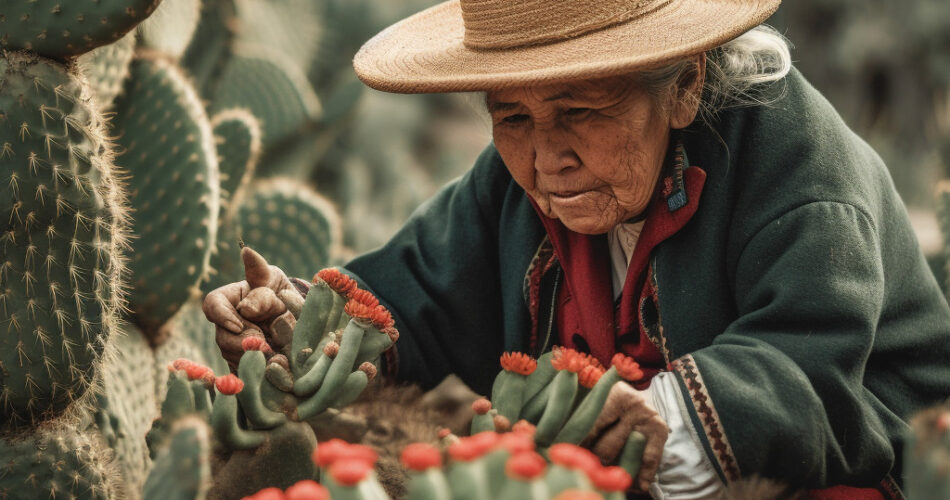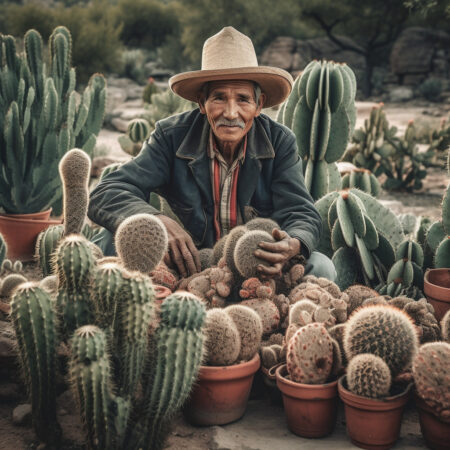Key Takeaways:
- Cacti have a rich history of cultivation across different cultures and continents.
- Ancient civilizations discovered the value of cacti as a food source and medicinal plant.
- Cultivating cacti holds deep spiritual and symbolic significance in many indigenous cultures.
- Cactus cultivation spread globally during the age of exploration.
- Traditional techniques for growing cacti include using well-draining soil and mastering propagation methods.
- Watering and fertilizing cacti requires finding the right balance.
- Cacti have been integrated into architecture, traditional cuisine, and traditional remedies.
- Advancements in technology and sustainability have revolutionized cactus cultivation.
- Growers are embracing organic and eco-friendly practices.
- Cacti can be creatively combined with other plants in contemporary gardens.
Cacti have captured the fascination of people around the world for centuries. These unique and resilient plants have a rich history of cultivation that spans across different cultures and continents. From ancient practices to modern innovations, the world of cactus cultivation is a tapestry of traditions and techniques that continue to thrive in the present day. In this comprehensive guide, we will explore the fascinating origins of cactus cultivation, traditional techniques for growing cacti, the global celebration of cactus cultivation, and the modern innovations that have revolutionized the field.
The Fascinating Origins of Cactus Cultivation
The story of cactus cultivation begins with ancient practices that have deep roots in human history. These early civilizations recognized the value and resilience of cacti and developed techniques to cultivate them for various purposes.
1. Deep Roots: Ancient Cactus Cultivation Practices
Centuries ago, indigenous communities in regions such as Mexico and Central America discovered the potential of cacti as a valuable food source and medicinal plant. They cultivated cacti such as the prickly pear and agave for their nutritious fruits and used them in traditional remedies for various ailments. These ancient cultivation practices laid the foundation for the understanding of cacti and their potential uses.
2. Sacred Symbols: Cactus Cultivation in Indigenous Cultures
In many indigenous cultures, cacti hold deep spiritual and symbolic significance. They are often associated with fertility, protection, and resilience. Cultivating cacti became an integral part of religious and cultural ceremonies, with rituals performed to honor these plants. Today, these traditions continue to be passed down through generations, preserving the sacred symbolism of cacti.
3. Spreading Across Continents: Cactus Cultivation during the Age of Exploration
The age of exploration brought cacti to new continents as explorers and botanists encountered these unique plants during their travels. They brought back cacti seeds and specimens to their homelands, leading to the establishment of cactus gardens and botanical collections. As interest in cacti grew, their cultivation practices spread across Europe and other parts of the world, becoming a global phenomenon.
Traditional Techniques for Growing Cacti
Growing cacti requires specialized knowledge and techniques due to their unique needs and characteristics. Traditional cultivation methods have been refined over time and continue to be practiced by enthusiasts and experts alike.
1. Soil Secrets: Unraveling the Idea Growing Medium
The choice of growing medium is crucial for the successful cultivation of cacti. These plants thrive in well-draining soil that replicates their natural habitat. A common mix for growing cacti includes a combination of sandy, rocky, and organic materials that provide excellent drainage while retaining some moisture. Some enthusiasts create their own soil mixtures by blending specific ratios of materials to suit different types of cacti.
2. Propagation Perfection: Mastering Cactus Reproduction Methods
Propagating cacti can be done through various methods, including seed germination, offsets, and stem cuttings. Each method requires specific techniques and timing to ensure successful reproduction. Seed germination often involves scarification to break the seed coat, while offsets are small plantlets that grow from the base of a mature cactus. Stem cuttings can be taken from healthy plants and rooted to create new individuals. Understanding the intricacies of each propagation method is essential for a successful cactus garden.
3. Nurturing with Care: Essential Tips for Watering and Fertilizing Cacti
Cacti have unique water and nutrient requirements due to their ability to store water in their tissues. Overwatering can lead to root rot, while under-watering can cause dehydration. Finding the right balance is key to ensuring the health and growth of cacti. Watering techniques such as the “soak and dry” method, where the soil is thoroughly soaked and then allowed to dry out before rewatering, are commonly recommended. Additionally, using a specialized cactus fertilizer during the growing season can provide the necessary nutrients without risking excessive growth.
Celebrating Cactus Cultivation Around the Globe
Throughout history, cacti have become integrated into various aspects of culture, cuisine, and traditional remedies. Their unique characteristics have found uses beyond their aesthetic appeal, making them an integral part of certain traditions and practices around the world.
1. Mesmerizing Masterpieces: Architectural Integration of Cacti in Desert Landscapes
The stunning beauty of cacti has inspired architects and landscapers to incorporate them into desert landscapes. In regions such as the American Southwest and Mexico, cacti are carefully selected and strategically placed to create breathtaking displays. These architectural integrations highlight the natural beauty and resilience of cacti and enhance the overall visual appeal of the landscape.
2. Prickly Gourmet: Exploring the Culinary Uses of Cacti in Traditional Cuisine
Cacti, particularly the prickly pear, have long been used in traditional cuisine. The tender young pads, known as nopalitos, are harvested and cooked in various dishes. They offer a unique texture and mild flavor that adds complexity to Mexican and Southwestern recipes. Prickly pear fruits, known as tunas, are also used in desserts, beverages, and preserves. Exploring the culinary possibilities of cacti reveals a rich cultural heritage connected to these resilient plants.
3. Healing Powers: Medicinal Applications of Cacti in Traditional Remedies
Cacti have a long history of being used for their medicinal properties. Indigenous cultures have relied on cacti for remedies for various ailments and conditions. For example, the sap of certain cacti has been used to treat burns and skin irritations, while others have been used for their anti-inflammatory properties. Scientific research continues to uncover the potential health benefits of cacti, shedding light on the traditional wisdom that has been passed down for generations.
Modern Innovations in Cactus Cultivation
The world of cactus cultivation has seen significant advancements in recent years, driven by technology, sustainability, and creative experimentation. These modern innovations have expanded the possibilities and accessibility of growing cacti.
1. High-Tech Horticulture: Harnessing Technology for Optimal Cactus Growth
Advancements in technology have revolutionized the way cacti are cultivated. Automated irrigation systems and climate control tools enable precise control over environmental factors, ensuring optimal growth conditions. Growers can also use specialized sensors and monitoring systems to track the health and needs of their cacti. These technological advancements have made it easier for both professionals and hobbyists to achieve successful cultivation results.
2. Sustainable Solutions: Organic and Eco-Friendly Practices for Cactus Cultivation
In an era of sustainability, many growers are embracing organic and eco-friendly practices for cactus cultivation. These practices minimize the use of synthetic fertilizers and pesticides, opting for natural alternatives that are safe for the environment. Additionally, water conservation techniques such as rainwater harvesting and drip irrigation systems help reduce water usage. By adopting sustainable solutions, cactus growers contribute to the preservation of these remarkable plants and their ecosystems.
3. Creative Combinations: Blending Cacti with Other Plants in Contemporary Gardens
The art of combining different plants in garden design has extended to cacti as well. Contemporary gardens often feature creative combinations of cacti with other succulents, ornamental grasses, and flowering plants. These design choices create dynamic and visually captivating landscapes that showcase the diversity of plant life. By blending cacti with other plants, gardeners can create unique and harmonious compositions that highlight the beauty of these beloved desert inhabitants.
In conclusion, the world of cactus cultivation is a vast and ever-evolving landscape. From ancient practices to modern innovations, the traditions and techniques associated with growing cacti continue to captivate enthusiasts and experts alike. Whether it’s delving into the origins of cactus cultivation, mastering traditional techniques, celebrating the global influence of cacti, or exploring modern advancements, there is always something new to discover in the world of cacti.
FAQ
Question: Are all cacti edible?
Not all cacti are edible. Some cactus species, such as the prickly pear, have edible fruits and pads that are commonly used in cuisine. However, there are many cactus species that are not safe for consumption due to their toxic or potentially harmful properties.
Question: How often should I water my cactus?
The watering frequency for cacti depends on various factors such as the species, pot size, temperature, and humidity levels. As a general guideline, most cacti prefer infrequent but thorough watering, allowing the soil to dry out completely between each watering. Overwatering can lead to root rot, while underwatering can cause dehydration. It is important to find the right balance and adjust the watering schedule based on the specific needs of your cactus.
Question: Can I grow cacti indoors?
Yes, many cacti can be successfully grown indoors. It is important to provide them with adequate sunlight, preferably a south-facing window where they can receive bright, indirect light for several hours a day. Indoor cacti also benefit from good air circulation. Additionally, choosing the right pot with proper drainage and using a well-draining cactus mix are essential for indoor cactus cultivation.
Question: How do I protect my cacti from pests?
Pests such as mealybugs, scale insects, and spider mites can infest cacti. To protect your cacti from pests, regularly inspect the plants for any signs of infestation, such as cottony residue or tiny crawling insects. If pests are detected, you can manually remove them using a cotton swab dipped in rubbing alcohol or use organic insecticidal soap. Maintaining good hygiene, such as removing fallen leaves or debris, can also help prevent pest problems.
Question: Can I propagate cacti from seeds?
Yes, cacti can be propagated from seeds. However, it is important to note that growing cacti from seeds can be a slow and challenging process. Some species require specific conditions for successful germination, such as scarification (breaking the seed coat) or stratification (exposing seeds to cold temperatures). It is recommended to research the specific requirements for the cactus species you wish to propagate from seeds.
Question: How can I prevent root rot in my cactus?
To prevent root rot in your cactus, it is important to ensure proper drainage. Using a well-draining cactus mix and a pot with drainage holes can help excess water to escape and prevent water from sitting around the roots. Avoid overwatering and allow the soil to dry out completely between waterings. Additionally, providing good air circulation and avoiding excessive humidity can also help prevent root rot.
Question: Can cacti be grown in cold climates?
Some cacti species are more cold-tolerant than others and can be grown in cold climates. Cold-hardy cacti, such as Opuntia species, can withstand freezing temperatures and are suitable for colder regions. However, it is important to protect them from excessive moisture during winter and provide them with proper insulation, such as covering them with a frost cloth or moving them to a sheltered location.
Question: Can cacti be grown from cuttings?
Yes, cacti can be propagated from stem cuttings. Select a healthy stem segment and let it callus over for a few days to a week. Then, plant the cutting in well-draining soil or a cactus mix. It is important to place the cutting in a warm and bright location but avoid direct sunlight until it has developed roots. With time and proper care, the cutting will grow roots and establish itself as a new cactus plant.





Comments